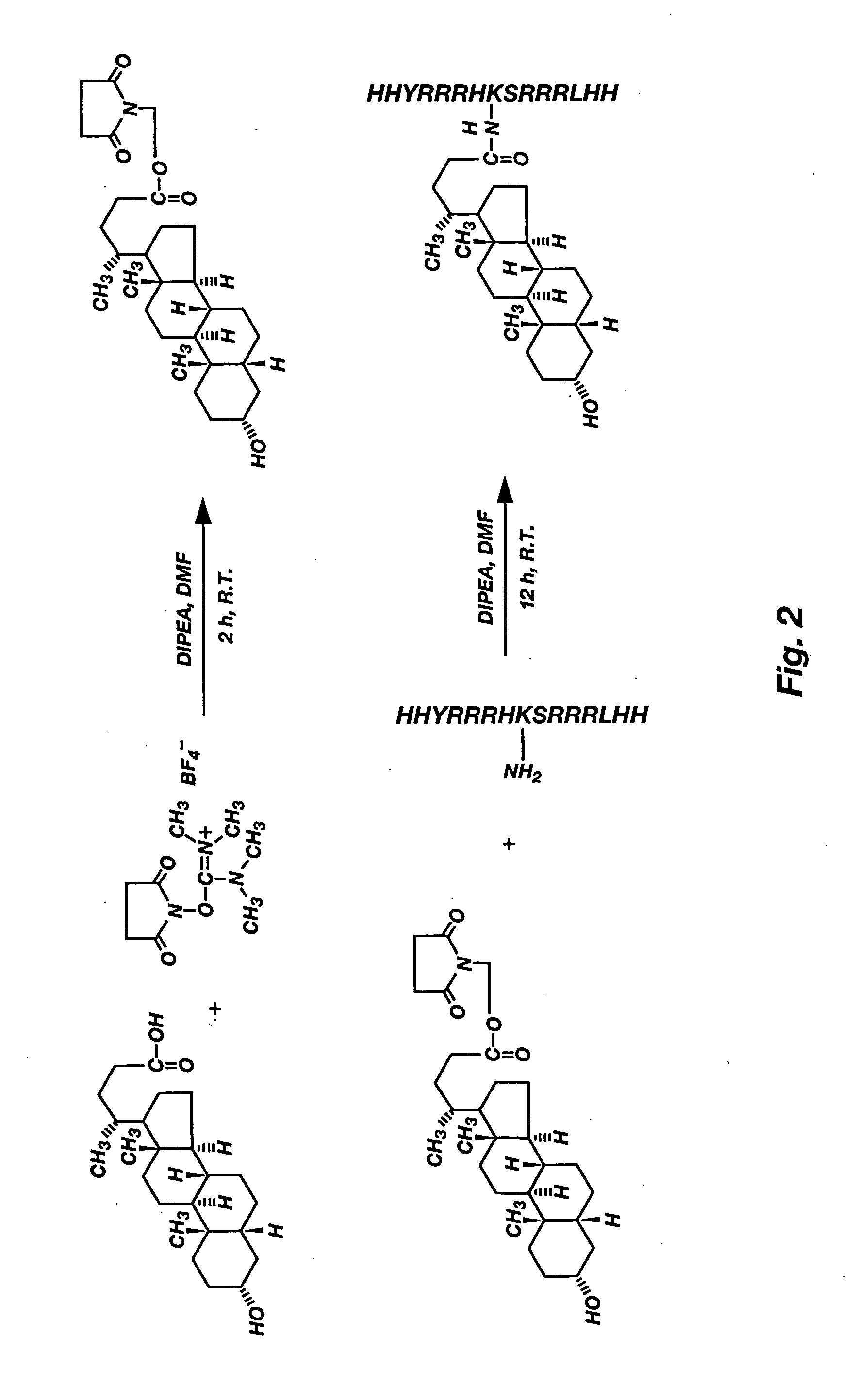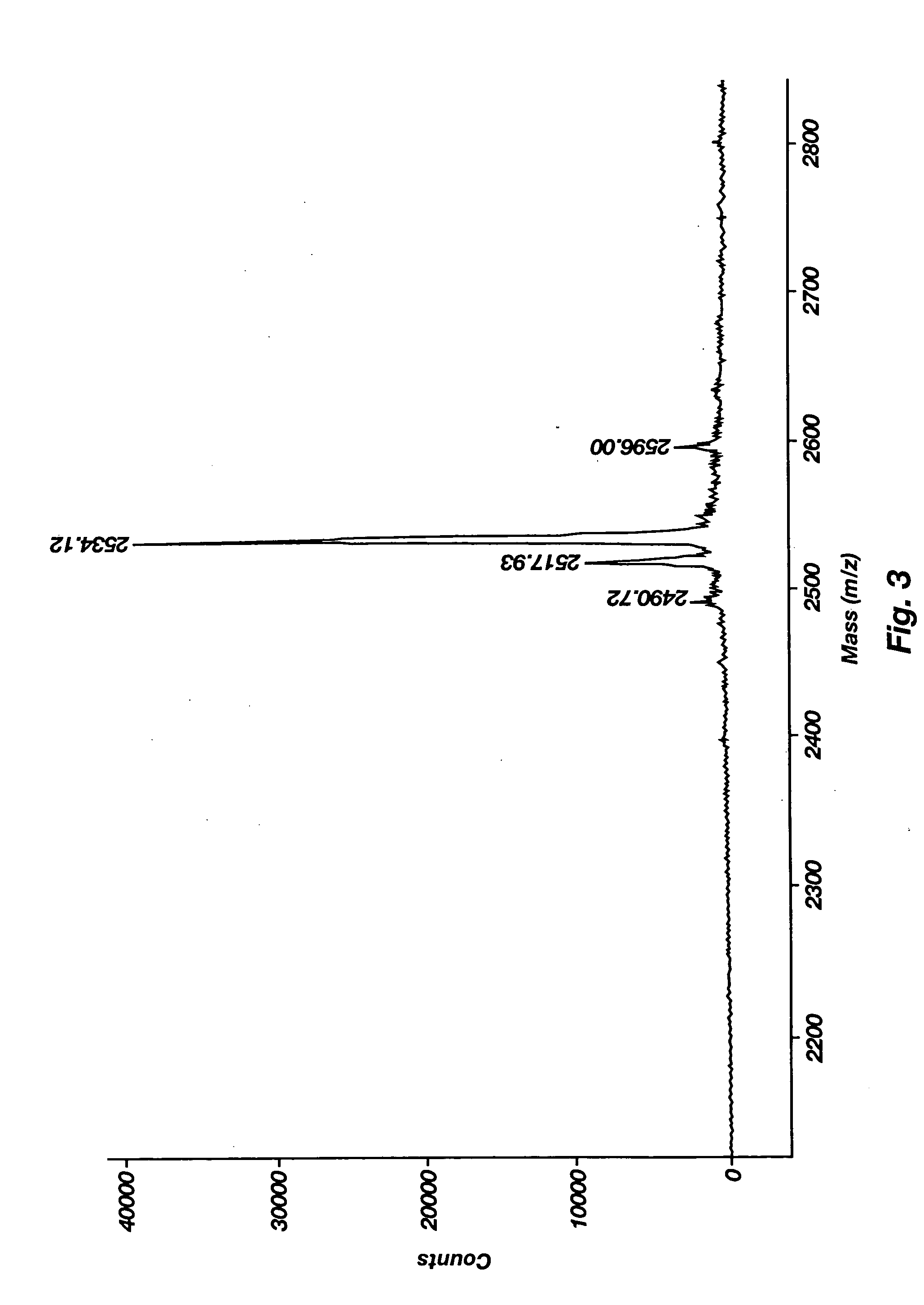Soluble steroidal peptides for nucleic acid delivery
a nucleic acid and steroidal peptide technology, applied in the field of gene delivery, can solve the problems of inability to achieve remote and impractical feasibility of single vector serving as universal gene carrier for all disease targets, and inability to achieve carrier-associated toxicities
- Summary
- Abstract
- Description
- Claims
- Application Information
AI Technical Summary
Benefits of technology
Problems solved by technology
Method used
Image
Examples
example 1
Synthesis, Purification, and Physicochemical Characterization
[0042] The hydrophilic peptide head group of an illustrative amphiphilic lipopeptide, SSP, is based on the peptide sequence His-Tyr-Arg-Arg-Arg-His-Cys-Ser-Arg-Arg-Arg-Leu-His (SEQ ID NO:1) corresponding to amino acid residues 51-63 of human protamine 2 (PRM2), which is rich in arginine and histidines. The cysteine residue at amino acid 57 amino acid was replaced with lysine for providing an ε-amino group for linkage to a hydrophobic moiety, and an additional histidine residue was included on both the N-terminus and the C-terminus to yield the peptide chain His-His-Tyr-Arg-Arg-Arg-His-Lys-Ser-Arg-Arg-Arg-Leu-His-His (SEQ ID NO:2). The entire synthesis scheme is shown in FIG. 2.
[0043] The peptide H2N-His-His-Tyr-Arg-Arg-Arg-His-Lys-Ser-Arg-Arg-Arg-Leu-His-His-COOH (SEQ ID NO:2) was synthesized by solid phase method on rink amide resin using the standard 9-fluorenylmethoxycarbonyl (Fmoc) strategy on an Applied Biosystems 4...
example 2
[0044] The procedure of Example 1 was followed except that 413.7 mg of cholesteryl carboxylic acid (CA) was substituted for lithocholic acid.
[0045] Cholest-5-ene-3β-carboxylic acid (CCA) was synthesized as follows. A solution of methyl magnesium iodide was prepared under reflux by pouring 25 ml tetrahydrofuran (THF) on 400 mg Mg turnings with a pinch of iodine and a few drops of CH3I in a 3-neck flask for 10 min. After the vigorous reaction subsided, a solution of 4 g 3β-chlorocholest-5-ene in 50 ml THF was added drop wise over a period of 3 hours. After refluxing for 3 hours, the reaction was cooled to room temperature. To this mixture was poured finely ground dry ice (10 g), followed by stirring for 1 hour. This solution was cooled in an ice bath and hydrolyzed by adding ice cold 1 M H2SO4 (100 ml). After stirring for 5 min, 10 g NaCl and 100 ml diethyl ether were added. The layers were separated, and then the aqueous layer (bottom layer) was again extracted with diethyl ether (1...
example 3
Membrane Permeabilization Study
[0046] Membrane permeabilization studies were performed to find out whether SSP was able to form pores through plasma membranes and whether this phenomenon had any pH dependence or not. SSP prepared according to Example 1 was used at micromolar concentrations on cells preincubated with ethidium bromide, which intercalates between the strands of dsDNA and causes it to fluoresce. Ethidium bromide on its own is a poor membrane permeant, however, if the membranes are permeabilized, it would rapidly cross the cytoplasm, accumulate in the nucleus, and bind to the cellular DNA. Its fluorescent property would allow us to thus find the extent to which permeabilization via SSP occurred.
[0047] The membrane permeabilization activity of SSP was determined using flow cytometry. CT-26 cells were grown overnight and at 70-80% confluency were trypsinized and centrifuged. Cells were washed several times in 1×PBS (pH 7.4) and eventually resuspended in it to make cell s...
PUM
| Property | Measurement | Unit |
|---|---|---|
| pH | aaaaa | aaaaa |
| pH | aaaaa | aaaaa |
| concentration | aaaaa | aaaaa |
Abstract
Description
Claims
Application Information
 Login to View More
Login to View More - R&D
- Intellectual Property
- Life Sciences
- Materials
- Tech Scout
- Unparalleled Data Quality
- Higher Quality Content
- 60% Fewer Hallucinations
Browse by: Latest US Patents, China's latest patents, Technical Efficacy Thesaurus, Application Domain, Technology Topic, Popular Technical Reports.
© 2025 PatSnap. All rights reserved.Legal|Privacy policy|Modern Slavery Act Transparency Statement|Sitemap|About US| Contact US: help@patsnap.com



